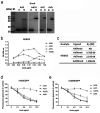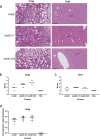Higher affinities of fibers with cell receptors increase the infection capacity and virulence of human adenovirus type 7 and type 55 compared to type 3
- PMID: 38018973
- PMCID: PMC10783091
- DOI: 10.1128/spectrum.01090-23
Higher affinities of fibers with cell receptors increase the infection capacity and virulence of human adenovirus type 7 and type 55 compared to type 3
Abstract
HAdV-3, -7, and -55 are the predominant types causing acute respiratory disease outbreaks and can lead to severe and fatal pneumonia in children and adults. In recent years, emerging or re-emerging strains of HAdV-7 and HAdV-55 have caused multiple outbreaks globally in both civilian and military populations, drawing increased attention. Clinical studies have reported that HAdV-7 and HAdV-55 cause more severe pneumonia than HAdV-3. This study aimed to investigate the mechanisms explaining the higher severity of HAdV-7 and HAdV-55 infection compared to HAdV-3 infection. Our findings provided evidence linking the receptor-binding protein fiber to stronger infectivity of the strains mentioned above by comparing several fiber-chimeric or fiber-replaced adenoviruses. Our study improves our understanding of adenovirus infection and highlights potential implications, including in novel vector and vaccine development.
Keywords: adenoviruses; pathogenesis; pneumonia; receptors; respiratory viruses; virulence.
Conflict of interest statement
The authors declare no conflict of interest.
Figures







References
-
- Baker AT, Davies JA, Bates EA, Moses E, Mundy RM, Marlow G, Cole DK, Bliss CM, Rizkallah PJ, Parker AL. 2021. The fiber knob protein of human adenovirus type 49 mediates highly efficient and promiscuous infection of cancer cell lines using a novel cell entry mechanism. J Virol 95:e01849-20. doi:10.1128/JVI.01849-20 - DOI - PMC - PubMed
-
- Adams MJ, Lefkowitz EJ, King AMQ, Harrach B, Harrison RL, Knowles NJ, Kropinski AM, Krupovic M, Kuhn JH, Mushegian AR, Nibert M, Sabanadzovic S, Sanfaçon H, Siddell SG, Simmonds P, Varsani A, Zerbini FM, Gorbalenya AE, Davison AJ. 2017. Changes to taxonomy and the international code of virus classification and nomenclature ratified by the international committee on taxonomy of viruses. Arch Virol 162:2505–2538. doi:10.1007/s00705-017-3358-5 - DOI - PubMed
MeSH terms
Grants and funding
- 82072264, 31570163/MOST | National Natural Science Foundation of China (NSFC)
- 2021A1515011071/GDSTC | Natural Science Foundation of Guangdong Province ()
- 202102010364-ZNSA-2020003/Bureau of Science and Information Technology of Guangzhou Municipality | Guangzhou Municipal Research Collaborative Innovation Projects (Guangzhou Research Collaborative Innovation Projects)
- YW-YWYM0501/Scientific Research Initiation
LinkOut - more resources
Full Text Sources
Medical

